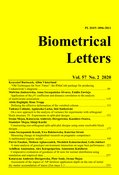
Biometrical Letters Vol. 57(2), 2020, pp. 177-194


We consider a new method of constructing non-orthogonal (incomplete) split-split-plot designs (SSPDs) for three (A, B, C) factor experiments. The final design is generated by some resolvable incomplete block design (for the factor A) and by square lattice designs for factors B and C using a modified Kronecker product of those designs (incidence matrices). Statistical properties of the constructed designs are investigated under a randomized-derived linear model. This model is strictly connected with a four-step randomization of units (blocks, whole plots, subplots, sub-subplots inside each block). The final SSPD has orthogonal block structure (OBS) and satisfies the general balance (GB) property. The statistical analysis of experiments performed in the SSPD is based on the analysis of variance often used for multistratum experiments. We characterize the SSPD with respect to the stratum efficiency factors for the basic estimable treatment contrasts. The structures of the vectors defining treatment contrasts are also given.

General balance property, Efficiency factors, Incomplete split-split-plot designs, Khatri–Rao product of matrices, Resolvable designs

